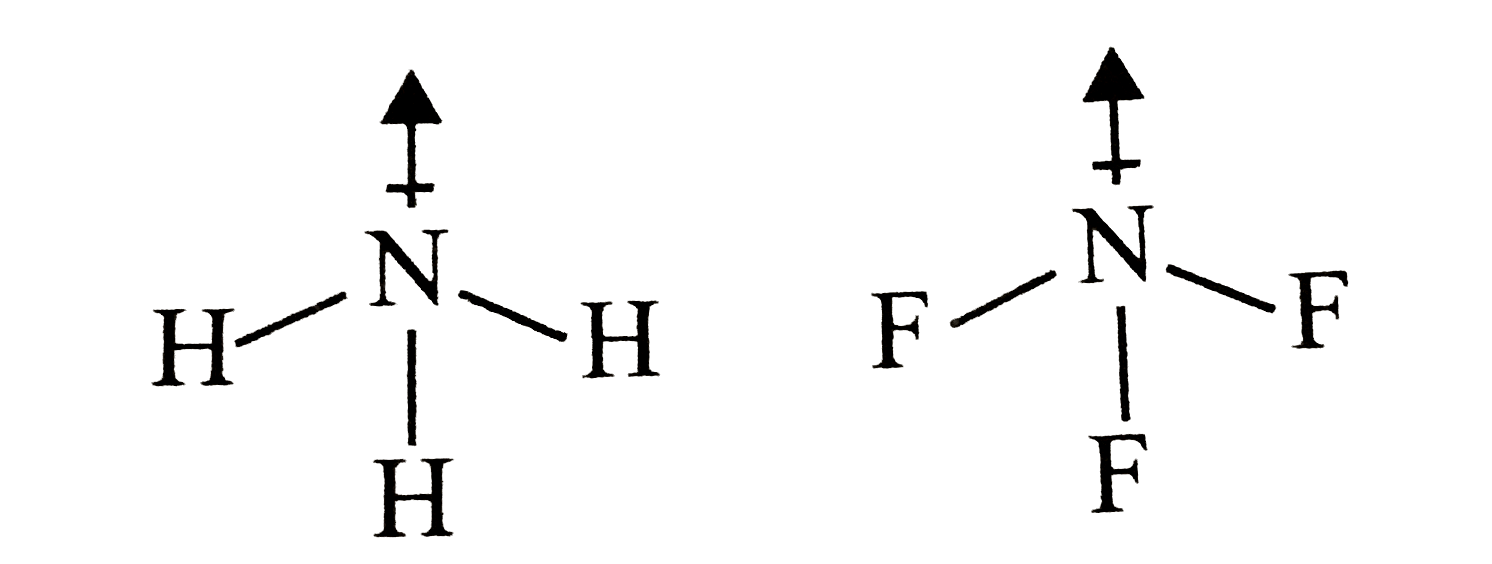The electronegaivity difference between N and F is greater than that between N and H yet the dipole moment of NH3 ( 1 .5 D) is larger than that of NF3(0.2D). This is because :
in NH3 as well as in NF3 , the atomic dipole and bond dipole are in the same direction
in NH3, the atomic dipole and bond dipole are in the same direction whereas in NF3 these are in opposite directions
in NH3 as well as NF3 , the atomic dipole and bond dipole are in opposite directions
in NH3 the atomic dipole and bond dipole are in the opposite directions whereas in NF3 these are in the same directions
The correct Answer is:B
To solve the question regarding the dipole moments of NH3 and NF3, we need to analyze the molecular structure and the direction of dipole moments in both molecules. Here's a step-by-step breakdown of the solution:
Step 1: Understand Electronegativity
- Electronegativity is the ability of an atom to attract electrons in a bond. Fluorine (F) is more electronegative than hydrogen (H), and nitrogen (N) is less electronegative than both.
- The electronegativity difference between N and F is greater than that between N and H.
Hint: Remember that a larger electronegativity difference usually leads to a stronger bond dipole.
Step 2: Analyze Molecular Geometry
- Both NH3 (ammonia) and NF3 (nitrogen trifluoride) have a trigonal pyramidal shape due to the presence of a lone pair on nitrogen.
- The molecular geometry affects how the dipoles from the bonds and the lone pair combine.
Hint: Consider how the shape of the molecule influences the resultant dipole moment.
Step 3: Determine the Direction of Dipole Moments
- In NH3, the bond dipoles (N-H) point towards hydrogen, and the lone pair dipole points upwards. Both the bond dipole and the atomic dipole (due to the lone pair) point in the same direction (upwards).
- In NF3, the bond dipoles (N-F) point towards fluorine, while the lone pair dipole still points upwards. However, the bond dipoles point downwards, leading to a cancellation effect.
Hint: Visualize the vectors representing the dipole moments to see how they add or cancel out.
Step 4: Calculate the Resultant Dipole Moment
- For NH3, the dipole moments add constructively, resulting in a larger overall dipole moment.
- For NF3, the bond dipoles and the atomic dipole cancel each other out to some extent, resulting in a smaller dipole moment.
Hint: Think about vector addition; when dipoles point in the same direction, they add up, while if they point in opposite directions, they can cancel each other out.
Step 5: Conclusion
- The dipole moment of NH3 (1.5 D) is larger than that of NF3 (0.2 D) because in NH3, the atomic dipole and bond dipole are in the same direction, while in NF3, they are in opposite directions.
Final Answer: The correct reason is that the atomic dipole and bond dipole in NH3 are in the same direction, whereas in NF3, they are in opposite directions.
- Electronegativity is the ability of an atom to attract electrons in a bond. Fluorine (F) is more electronegative than hydrogen (H), and nitrogen (N) is less electronegative than both.
- The electronegativity difference between N and F is greater than that between N and H.
- Both NH3 (ammonia) and NF3 (nitrogen trifluoride) have a trigonal pyramidal shape due to the presence of a lone pair on nitrogen.
- The molecular geometry affects how the dipoles from the bonds and the lone pair combine.
- In NH3, the bond dipoles (N-H) point towards hydrogen, and the lone pair dipole points upwards. Both the bond dipole and the atomic dipole (due to the lone pair) point in the same direction (upwards).
- In NF3, the bond dipoles (N-F) point towards fluorine, while the lone pair dipole still points upwards. However, the bond dipoles point downwards, leading to a cancellation effect.
- For NH3, the dipole moments add constructively, resulting in a larger overall dipole moment.
- For NF3, the bond dipoles and the atomic dipole cancel each other out to some extent, resulting in a smaller dipole moment.
- The dipole moment of NH3 (1.5 D) is larger than that of NF3 (0.2 D) because in NH3, the atomic dipole and bond dipole are in the same direction, while in NF3, they are in opposite directions.
Similar Questions
Knowledge Check
The dipoles moment of NF3 is less than NH3 because
A4.90×10−30Cmand0.80×10−30CmB0.80×10−30Cmand4.90×10−30CmC4.90×10−30Cmand4.90×10−30CmD0.80×10−30Cmand0.80×10−30CmThe dipole moment of NF3 is much less as compared to that of NH3 because
A1. the size of N atom is much less than that of H atomB2. F atom is more electronegative than N atom, whereas H atom is less electronegative than N atomC3. unshared electron pair is not present inNF3D4. number of lone pairs in NF3 is much greater than in NH3.
The dipole moments of NH3,NF3 and H2O are in the order.
View SolutionDipole moment of NF3 is smaller than :
View SolutionThe dipole moment of H2O2 is more than that of H2O but H2O2 is not a good solvent because :
View SolutionThe dipole moment of H2O2 is more than that of H2O but H2O2 is not a good solvent because :
View SolutionExplain:
Dipole moment of MeCH2CHO (propanal) (2.5D)
is greater than that of but−1-ene (0.3D).
View SolutionAlthough F is more electronegative than H, the resultant dipole moment of NH3 is much more than that of NF3. It can be explained as

View Solution
